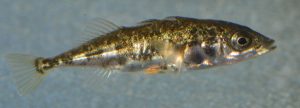Do fish favor one side of their bodies for certain behaviors? This might be a question you’ve never considered, but it makes sense to think about. Using the example of humans, a (sometimes problematic) tendency that we exhibit even when considering other species, there tends to be a dominant hand, a dominant eye, and other cases of preference for one side of the body over the other. These are examples of behavioral laterality, or the preference for one side of the body when completing certain tasks. The logical question is, how does this laterality work in other species, and what are the underlying biological features that contribute to its presence?
A research paper by Planidin and Reimchen published in the Journal of Experimental Biology sought to look further into these questions specifically related to a species called Threespine Stickleback, Gasteroasteus aculeatus. They collected the fish for their study from Eagle Lake in Canada. Another characteristic of the fish that was important to their research was the lateral line. The lateral line is an organ that is used for mechanical sensory systems in fish and it is composed of neuromasts, organs which are made up of sensory cells. The importance of this lateral line and its component parts, is that it’s implicated in motion, vibration, pressure, and other mechanical stimuli that can help the fish to better respond to their environment, and survive. The researchers were asking the overarching question of whether asymmetry in the lateral line, differences in the amount of neuromasts on each side of the fish, had any correlation with the behavioral laterality, or side that the fish favored for certain behaviors. Within that question, they sought to understand if this was consistent across a population, or group of fish procured from the same ecological habitat, in this case Eagle Lake.

Threespine Stickleback, Gasteroasteus aculeatus (Wiki Commons)
The hypothesis in this paper was relatively simple and not terribly specific: that the differences in the amount of sensory organs (neuromasts) on either side of the fish would be correlated with its preference for one side rather than the other during certain behaviors. They did not make any specific predictions regarding each behavior that they were testing, but they did think there would be a correlation. They focused on three behaviors for their experimentation: escape from predators, finding prey, and rheotaxis which is the orientation or movement of the fish in response to water flow.
In regard to escape from predators, the fish were analyzed based on their response to a stream of water being released next to them to simulate a predator attack. In general they were more likely to expose their left side and try to escape when the “attack” came from the right. It was also more common for fish with less neuromasts to respond more often and more intensely. Regarding prey location, the fish were exposed to a vibration, and did not exhibit a response, but were more likely to have their right side against the wall of the test enclosure, and those with less neuromasts had this tendency even more. Lastly, for rheotaxis, two tracks were used, one with the current going clockwise, and the other counterclockwise. There was no association found between the number of neuromasts and the resulting behavior. The asymmetry, or number of sensory organs (neuromasts) on each side of the fish did not have any significant effect on any of the behaviors. They did find that the laterality was most clear and common during the first trials of their experiment, and its presence was less clear over time. In general, few results were deemed significant and the preference of the individual fish for one side was highly variable, which does not support the hypothesis that there would be a significant correlation between the differences across the lateral line and side preferences. However, the associations that were found are definitely valuable for this research.
The researchers provide some thoughts regarding why their results were so variable and not significant. A new hypothesis could be that laterality will not clearly appear at the population level because it depends on individual learning and life experiences, which may equip the fish with better survival mechanisms. The fact that the fish became used to the trials, reducing laterality over time, implies the potential for some kind of learning. Clearly laterality is much more complex than the researchers thought. We can see from this study that the neuromasts and lateral line are likely not the only thing influencing the side preferences of the fish for each behavior. Something else that probably plays a role is that sensory systems can’t be assumed to work alone, and there is a likelihood that multiple senses are impacting laterality. The focus on mechanical stimuli without inclusion of vision or olfaction could certainly lead to a piece of this story missing.
So, a lack of significant results doesn’t mean that nothing was gained. Just from this experiment we are able to develop a variety of new questions and exciting new ways to think about the mechanical sensory systems of fish, and why they might vary to help individuals survive. Why were the responses of the fish so individualized, and not consistent across the population? Are they learning, or integrating their sensory systems to better understand their environment? This research shows us that sensory ecology is adaptive and complex, and the new questions that experiments like this one provide prompt further exploration that can be applied to a huge variety of species.
Literature Cited:
Planidin, N. P., & Reimchen, T. E. (2022). Behavioural responses of threespine stickleback with lateral line asymmetries to experimental mechanosensory stimuli. Journal of Experimental Biology, 225(2). https://doi.org/10.1242/jeb.243661
